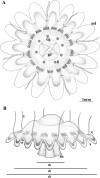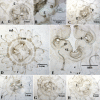New record of Nausithoe werneri (Scyphozoa, Coronatae, Nausithoidae) from the Brazilian coast and a new synonymy for Nausithoe maculata
- PMID: 33223866
- PMCID: PMC7658188
- DOI: 10.3897/zookeys.984.56380
New record of Nausithoe werneri (Scyphozoa, Coronatae, Nausithoidae) from the Brazilian coast and a new synonymy for Nausithoe maculata
Abstract
The order Coronatae (Scyphozoa) includes six families, of which Nausithoidae Haeckel, 1880 is the most diverse with 26 species. Along the Brazilian coast, three species of the genus Nausithoe Kölliker, 1853 have been recorded: Nausithoe atlantica Broch, 1914, Nausithoe punctata Kölliker, 1853, and Nausithoe aurea Silveira & Morandini, 1997. Living polyps (n = 9) of an unidentified nausithoid were collected in September 2002 off Arraial do Cabo (Rio de Janeiro, southeastern Brazil) at a depth of 227 m, and have been kept in culture since then. We compared these specimens with three species cultured in our laboratory: Nausithoe aurea (from Ilhabela, São Paulo, Brazil), Nausithoe maculata Jarms, 1990 (from Cuba and Puerto Rico), and Nausithoe werneri Jarms, 1990 (from the Atlantic Ocean off Morocco and from the Mediterranean Sea). The criteria used for comparison were: main aspects of the morphology, life cycle, and DNA sequences (18S, 28S, and COI). The results indicate that the unidentified polyps belong to N. werneri. Furthermore, N. aurea is considered a junior synonym of N. maculata.
Keywords: Coronamedusae; jellyfish; life cycle; periderm; polyp; scyphomedusae; systematics.
Clarissa Garbi Molinari, Maximiliano Manuel Maronna, André Carrara Morandini.
Figures







References
-
- Allman GJ. (1874) Report on the Hydroida collected during the Expeditions of H.M.S. ‘Porcupine’. Transactions of the Zoological Society of London 8(8): 469–481. [pls 65–68] 10.1111/j.1096-3642.1874.tb00566.x - DOI
-
- Broch H. (1913) Scyphomedusae from the “Michael Sars” North Atlantic Deep-Sea Expedition 1910. Report on the Scientific Results of the “Michael Sars” North Atlantic Deep-Sea Expedition 3(4): 1–20. [pl. I]
-
- Calder DR. (2009) Cubozoan and scyphozoan jellyfishes of the Carolinian biogeographic province, southeastern USA. Royal Ontario Museum Contributions in Science 3: 1–58.
-
- Collins AG. (2009) Recent insights into cnidarian phylogeny. Smithsonian Contributions to the Marine Sciences 38: 139–149.
-
- Dawson MN. (2005) Renaissance taxonomy: integrative evolutionary analyses in the classification of Scyphozoa. Journal of the Marine Biological Association of the UK 85(3): 733–739. 10.1017/S0025315405011641 - DOI
LinkOut - more resources
Full Text Sources
